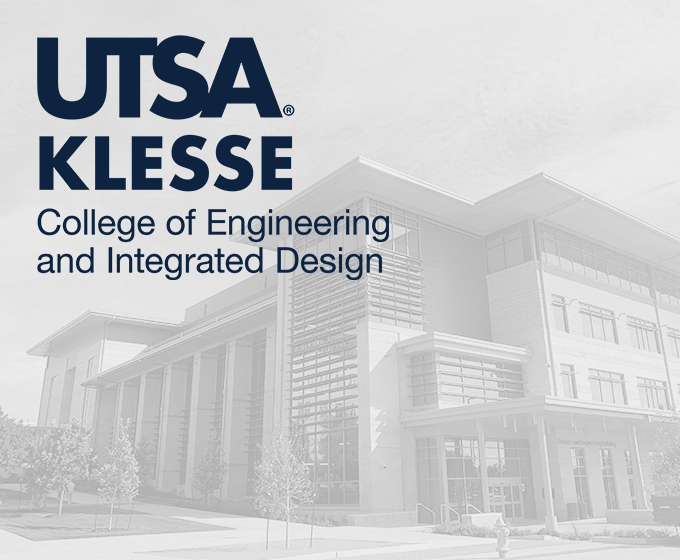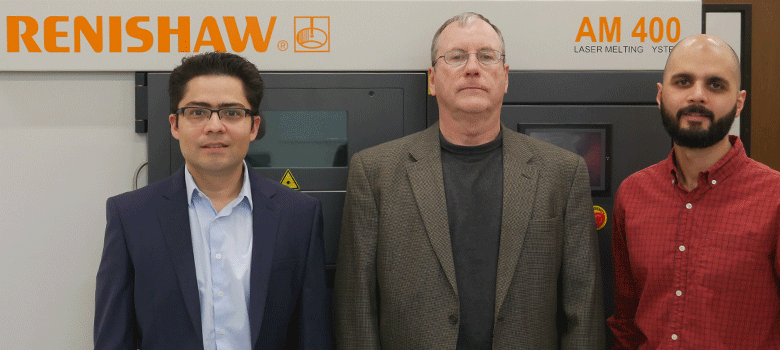
MARCH 4, 2022 — Researchers from the Margie and Bill Klesse College of Engineering and Integrated Design at UTSA are advancing work on a three-year, $659,970 grant from the U.S. Department of Defense’s Army Research Office to improve the military’s capacity to produce parts for critical machinery including aircraft. The researchers will focus on increasing the reliability of the additive manufacturing (AM) or metal 3D-printing process.
The research team includes David Restrepo, assistant professor in the UTSA Department of Mechanical Engineering; Harry Millwater, the department’s Samuel G. Dawson Endowed Professor; and Arturo Montoya, associate professor of mechanical engineering and civil and environmental engineering. They have been working on new computational designs that could lead to a more reliable additive-manufactured product.

UTSA researchers Arturo Montoya, Harry Millwater and David Restrepo stand in front of the Renishaw 3D printer at the Makerspace in the Science and Engineering Building. Their new computational designs could lead to more reliable additive-manufactured products.
AM is a rapidly growing segment of the engineering industry, expected to grow from $14 billion in 2018 to more than $350 billion by 2035.
Working directly from a digital model, additive manufacturing 3D-prints objects layer by layer, enabling new designs and innovations that were not possible before. Unlike the traditional manufacturing process, AM makes it possible to develop custom-made parts on-site for specific uses, mitigating issues such as transport, storage, long lead times and considerable excess inventory.
The drawback to AM is a lack of quality fabricated parts. AM involves laser-heating powders to create a shape, a process known as laser sintering. One significant challenge with the current technology is the uncertainty of the mechanical properties and the stability of the components when the powder cools and solidifies.
“One of the challenges of metal AM is the difficulty of knowing with 100% certainty what the mechanical properties (such as stiffness and strength) are in the printed components,” Restrepo explained. “It is also challenging to predict or reduce the dimensional variability of the components when compared with the design specifications. These challenges mean that printed parts currently cannot be certified to use in critical components—those that, if a failure occurs, may compromise human lives.”
Restrepo added, “We are modeling the laser sintering process to predict the mechanical properties and dimensional stability of the components fabricated with AM. The unique ingredient in our models is a UTSA-developed technology for sensitivity analysis. This unique technology will allow us to predict the mechanical properties, reliability and qualifications of AM-generated parts.”
The team’s research has been made possible through the resources in the UTSA Makerspace. The researchers are using its recently unveiled Renishaw 3D printer, a philanthropic donation by long-time supporter Edward Whitacre Jr.
Renishaw’s 3D printing technology is an integral part to the research project. It allows faculty members and student researchers to fabricate parts and collect data that will either affirm their computational models or illuminate necessary changes to calculations.
“UTSA’s state-of-the art Makerspace offers technology to students and faculty that greatly expands opportunities to conduct research, explore and build,” Millwater said. “The 3D Renishaw printer is an industry-leading tool that our students can work with throughout their time as a Roadrunner so they emerge ready to contribute to their careers from day one.”
“As the use of AM proliferates throughout more and more business sectors, exposing our students to its applications throughout their degree programs is of increasing importance,” Montoya added. “Whether students will employ AM in their careers, a functional understanding of the practice is particularly useful for the engineers of the future.”
Four additional mechanical engineering researchers at varying levels are working on the project including undergraduate Tim Clairmont, graduate student Aaron Rios, doctoral candidate Juan Sebastian Rincon and postdoctoral fellow Mauricio Aristizabal.
Restrepo stated that he is always looking for new opportunities for students to engage with hands-on research as part of their studies.
“In my experience, all of the professors at UTSA are happy to bring students into their research projects,” he said. “If you’re interested, stop by office hours or send an email to a professor pursuing research that interests you.”
“Our students are offered many opportunities to develop hands-on skills through experiential learning opportunities, such as this research project,” added JoAnn Browning, dean of the Klesse College. “Our new Makerspace and the technology it houses only furthers the potential for students to engage in unparalleled research and design opportunities, beginning as early as freshman year of their undergraduate degrees.”
UTSA is an urban serving Tier One research institution that is committed to tackling society’s grand challenges. It is driving San Antonio’s knowledge economy, living out the notion that great universities need great cities and great cities need great universities.
The UTSA Classroom to Career initiative incorporates experiential learning, including internships, service learning, undergraduate research and study abroad to help students gain the skills in demand by employers. The program is particularly important in linking classroom success to life after graduation for historically underserved populations. As part of its strategic plan, UTSA aims for 75% of its undergraduate students to participate in some type of experiential learning by the time they graduate.
This project, “A Fast and Effective Sensitivity and Uncertainty Quantification Method for Additively Manufactured Metals,” is funded by the U.S. Department of Defense (Grant W911NF2010315).
UTSA Today is produced by University Communications and Marketing, the official news source of The University of Texas at San Antonio. Send your feedback to news@utsa.edu. Keep up-to-date on UTSA news by visiting UTSA Today. Connect with UTSA online at Facebook, Twitter, Youtube and Instagram.
Move-in Day is an exciting time for incoming students. Students living in Alvarez Hall (2nd and 4th), and Chisholm Hall are moving in on August 19. The UTSA Housing and Residence Life (HRL) team looks forward to welcoming you all and helping you settle into your room.
Alvarez Hall and Chisholm HallMove-in Day is an exciting time for incoming students. Students living in Chaparral Village move in from August 20-21. The UTSA Housing and Residence Life (HRL) team looks forward to welcoming you all and helping you settle into your room.
Chaparral VillageMove-in Day is an exciting time for incoming students. Students living in Laurel Village move in on August 22. The UTSA Housing and Residence Life (HRL) team looks forward to welcoming you all and helping you settle into your room.
Laurel VillageThe College of Sciences welcomes our newest Roadrunners to UTSA at VIVA Science! This interactive event connects students with faculty, staff, student leaders, and peers while highlighting the opportunities available across the College.
Outdoor Learning Environment 2 (OLE), Flawn Building, Main CampusWe're excited to welcome the new class of UTSA College of Liberal and Fine Arts (COLFA) students to campus! Move In To COLFA is strongly recommended for new students in COLFA because it gives you the chance to learn about the Student Success Center, learn how to do college successfully and meet new friends.
Galleria (MH 2.01), McKinney Humanities Building, Main CampusBuild connections with your Alvarez College of Business peers and learn more about the Career Compass program! This opportunity will provide fun interactions, giveaways and a chance to meet your next friend!
Richard Liu Auditorium (BB 2.01.02,) Business Building, Main CampusCelebrate the end of summer and the start off a great fall semester with The Housing Block Party! This event will have live music, carnival-style treats, artists, games, and activities galore. Come and join us for a night of fun!
Multipurpose Room/Lawn, Guadalupe Hall, Main CampusThe University of Texas at San Antonio is dedicated to the advancement of knowledge through research and discovery, teaching and learning, community engagement and public service. As an institution of access and excellence, UTSA embraces multicultural traditions and serves as a center for intellectual and creative resources as well as a catalyst for socioeconomic development and the commercialization of intellectual property - for Texas, the nation and the world.
To be a premier public research university, providing access to educational excellence and preparing citizen leaders for the global environment.
We encourage an environment of dialogue and discovery, where integrity, excellence, respect, collaboration and innovation are fostered.